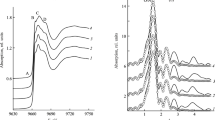Abstract
The hydrolysis of 2-methyl-4-benzyl-5(4H)oxazolone (MBA) in a mixture of water and MeCN has been studied — both the spontaneous reaction and that catalyzed by a complex of Cu(II) with (S)-2-[(N-benzylpropyl)amino]benzaldoxime (1). It has been shown that the complex 1 is an effective catalyst for the hydrolysis of MBA (chymotrypsin does not catalyze MBA hydrolysis). The mechanism of MBA hydrolysis catalyzed by this complex includes the formation of a mixed catalyst—substrate complex in which the MBA is coordinated with the metal ion through the N3 atom. It is suggested that the oxygen atom of the ionized oxime group in such a complex attacks the imine C2 atom of the MBA intramolecularly; this is the rate-determining stage. The change in the order of hydrolysis with respect to the catalyst from 1 to 1/2 when the concentration of 1 is increased indicates that the complex catalyst exists in aqueous solution in two forms, dimeric and monomeric, which are in equilibrium, and only the monomeric form of the complex is responsible for the catalysis. With an excess of the substrate we observe inhibition of the MBA hydrolysis — possibly an indirect indication of participation in the transition state by a water molecule coordinated in an apical position of the complex, which is displaced by excess substrate.
Similar content being viewed by others
Literature cited
J. P. Greenstein and M. Winitz,Chemistry of the Amino Acids, Wiley, New York (1961).
G. V. Chel'tsova, E. I. Karpeiskaya, and E. I. Klabunovskii,Izv. Akad. Nauk, Ser. Khim., No. 5, 1119 (1989).
J. de Jersey, P. Willadsen, and B. Zerner,Biochemistry,8, No. 5, 1959 (1969).
J. de Jersey and B. Zerner,Biochemistry,8, No. 5, 1967 (1969).
V. Daffe and J. Fastrez,J. Am. Chem. Soc.,102, No. 6, 3601 (1980).
V. Daffe and J. Fastrez,J. Chem. Soc., Perkin Trans. 2, No. 6, 789 (1983).
R. W. Hay, in:Metal Ions in Biological Systems, Vol. 5, H. Sigel (ed.), Marcel Dekker, New York (1976), p. 173.
H. Sigel,Chem. Rev.,82, No. 4, 385 (1982).
T. C. Curran, C. R. Farrar, O. Niazy, and A. Williams,J. Am. Chem. Soc.,102, No. 6, 6828 (1980).
V. Daffe and J. Fastrez,J. Chem. Soc., Perkin Trans. 2, No. 6, 783 (1983).
I. Z. Siemion and A. Dzugai,Rocz. Chem.,40, No. 10, 1699 (1966).
G. L. Schmir and B. A. Cunningham,J. Am. Chem. Soc.,87, No. 24, 5692 (1965).
E. S. Hand and W. P. Jencks,J. Am. Chem. Soc.,84, No. 18, 3503 (1982).
M. A. Wells, G. A. Rogers, and T. C. Bruice,J. Am. Chem. Soc.,98, No. 14, 4336 (1976).
J. T. Groves and R. R. H. Chambers,J. Am. Chem. Soc.,106, No. 3, 630 (1984).
Yu. N. Belokon', V. I. Tararov, T. F. Savel'eva, S. V. Vitt, E. A. Paskonova, S. K. Dotdaev, Yu. A. Borisov, Yu. T. Struchkov, A. S. Batasanov, and V. M. Belikov,Inorg. Chem. 27, No. 22, 4046 (1988).
K. Ogino, N. Kashihara, T. Fujita, T. Ueda, Isaka, and W. Tagaki,Chem. Lett., No. 7, 1303 (1987)
Yu. N. Belokon', I. B. Bachurina, V. I. Tararov, I. I. Tverdokhlebova, and O. I. Sutkevich,Izv. Akad. Nauk, Ser. Khim., No. 10, 2270 (1991).
E. I. Karpeiskaya, Doctoral Dissertation, Institute of Organic Chemistry, Russian Academy of Sciences, Moscow (1987).
F. A. Cotton and J. Wilkinson,Advanced Inorganic Chemistry, 3rd edn., Interscience, New York (1972).
M. Berymann, F. Stern, and C. Witte,Justus Liebigs Ann. Chem.,449, 277 (1926).
R. E. Steiger,J. Org. Chem.,9, No. 5, 396 (1944).
E. Mohr and F. Stroschein,Chem. Ber.,42, No. 11, 2521 (1909).
M. B. Saporovskaya, L. M. Volkova, and V. A. Pavlov,Zh. Anal. Khim.,44, 525 (1989).
Additional information
A. N. Nesmeyanov Institute of Heteroorganic Compounds, Russian Academy of Sciences, Moscow 117813. Translated from Izvestiya Akademii Nauk, Seriya Khimicheskaya, No. 3, pp. 536–546, March, 1992.
Rights and permissions
About this article
Cite this article
Belokon', Y.N., Bachurina, I.B., Tararov, V.I. et al. Mechanism of hydrolysis of azalactones catalyzed by a complex of Cu(II) with (S)-2-[(N-benzylpropyl)amino]benzaldoxime. Russ Chem Bull 41, 422–429 (1992). https://doi.org/10.1007/BF00863054
Received:
Issue Date:
DOI: https://doi.org/10.1007/BF00863054



